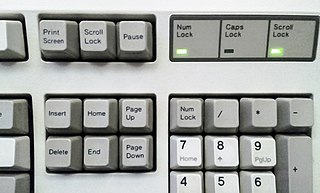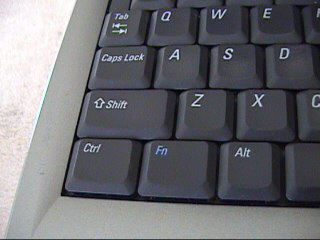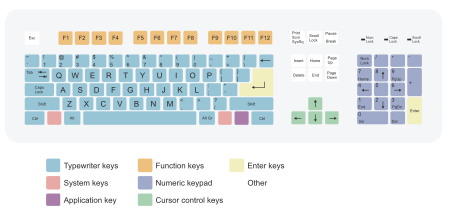The Break key of a computer keyboard refers to breaking a telegraph circuit and originated with 19th century practice. In modern usage, the key has no well-defined purpose, but while this is the case, it can be used by software for miscellaneous tasks, such as to switch between multiple login sessions, to terminate a program, or to interrupt a modem connection.
The keyboard for IBM PC-compatible computers is standardized. However, during the more than 30 years of PC architecture being frequently updated, many keyboard layout variations have been developed.

Scroll Lock is a lock key on most IBM-compatible computer keyboards. Depending on the operating system, it may be used for different purposes, and applications may assign functions to the key or change their behavior depending on its toggling state. The key is not frequently used, and therefore some reduced or specialized keyboards lack Scroll Lock altogether.

A telephone keypad is a keypad installed on a push-button telephone or similar telecommunication device for dialing a telephone number. It was standardized when the dual-tone multi-frequency signaling (DTMF) system was developed in the Bell System in the United States in the 1960s that replaced rotary dialing originally developed in electromechanical switching systems. Because of the installed abundance of rotary dial equipment well into the 1990s, many telephone keypads were also designed to produce loop-disconnect pulses electronically, and some could be optionally switched to produce either DTMF or pulses.

A function key is a key on a computer or terminal keyboard that can be programmed to cause the operating system or an application program to perform certain actions, a form of soft key. On some keyboards/computers, function keys may have default actions, accessible on power-on.
Microsoft has designed and sold a variety of ergonomic keyboards for computers. The oldest is the Microsoft Natural Keyboard, released in 1994, the company's first computer keyboard. The newest models are the Sculpt Ergonomic Keyboard (2013), the Surface Ergonomic Keyboard (2016), and the Microsoft Ergonomic Keyboard (2019).

Num Lock or Numeric Lock (⇭) is a key on the numeric keypad of most computer keyboards. It is a lock key, like Caps Lock and Scroll Lock. Its state affects the function of the numeric keypad commonly located to the right of the main keyboard and is commonly displayed by an LED built into the keyboard.
Mouse keys is a feature of some graphical user interfaces that uses the keyboard as a pointing device. Its roots lie in the earliest days of visual editors when line and column navigation was controlled with arrow keys. Today, mouse keys usually refers to the numeric keypad layout standardized with the introduction of the X Window System in 1984.

The Alt keyAlt on a computer keyboard is used to change (alternate) the function of other pressed keys. Thus, the Alt key is a modifier key, used in a similar fashion to the Shift key. For example, simply pressing A will type the letter 'a', but holding down the Alt key while pressing A will cause the computer to perform an Alt+A function, which varies from program to program. The international standard ISO/IEC 9995-2 calls it Alternate key. The key is located on either side of the space bar, but in non-US PC keyboard layouts, rather than a second Alt key, there is an 'Alt Gr' key to the right of the space bar. Both placements are in accordance with ISO/IEC 9995-2. With some keyboard mappings, the right Alt key can be reconfigured to function as an AltGr key although not engraved as such.
The degree symbol or degree sign, °, is a glyph or symbol that is used, among other things, to represent degrees of arc, hours, degrees of temperature or alcohol proof. The symbol consists of a small superscript circle.

Arrow keys or cursor movement keys are keys on a computer keyboard that are either programmed or designated to move the cursor in a specified direction.

A keypad is a block or pad of buttons set with an arrangement of digits, symbols, or alphabetical letters. Pads mostly containing numbers and used with computers are numeric keypads. Keypads are found on devices which require mainly numeric input such as calculators, television remotes, push-button telephones, vending machines, ATMs, point of sale terminals, combination locks, safes, and digital door locks. Many devices follow the E.161 standard for their arrangement.

Apple Inc. has designed and developed many external keyboard models for use with families of Apple computers, such as the Apple II, Mac, and iPad. The Magic Keyboard and Magic Keyboard with Numeric Keypad designed to be used via either Bluetooth and USB connectivity, and have integrated rechargeable batteries; The Smart Keyboard and Magic Keyboard accessories for iPads are designed to be directly attached to and powered by a host iPad. All current Apple keyboards utilize low-profile key designs, and common modifier keys.

Japanese input methods are used to input Japanese characters on a computer.

The Fn key, short form for function, is a modifier key on many keyboards, especially on laptops, used in a compact layout to combine keys which are normally kept separate. It is typically found on laptops due to their keyboard size restrictions. It is also found on many full-sized "multimedia" keyboards as the F-Lock key. It is mainly for the purpose of changing display or audio settings quickly, such as brightness, contrast, or volume, and is held down in conjunction with the appropriate key to change the settings.
On personal computers with numeric keypads that use Microsoft operating systems, such as Windows, many characters that do not have a dedicated key combination on the keyboard may nevertheless be entered using the Alt code. This is done by pressing and holding the Alt key, then typing a number on the keyboard's numeric keypad that identifies the character and then releasing Alt.
ISO/IEC 9995Information technology — Keyboard layouts for text and office systems is an ISO/IEC standard series defining layout principles for computer keyboards. It does not define specific layouts but provides the base for national and industry standards which define such layouts.

Unicode input is the insertion of a specific Unicode character on a computer by a user; it is a common way to input characters not directly supported by a physical keyboard. Unicode characters can be produced either by selecting them from a display or by typing a certain sequence of keys on a physical keyboard. In addition, a character produced by one of these methods in one web page or document can be copied into another. In contrast to ASCII's 96 element character set, Unicode encodes hundreds of thousands of graphemes (characters) from almost all of the world's written languages and many other signs and symbols besides.

A computer keyboard is a peripheral input device modeled after the typewriter keyboard which uses an arrangement of buttons or keys to act as mechanical levers or electronic switches. Replacing early punched cards and paper tape technology, interaction via teleprinter-style keyboards have been the main input method for computers since the 1970s, supplemented by the computer mouse since the 1980s.

In computing, an input device is a piece of equipment used to provide data and control signals to an information processing system, such as a computer or information appliance. Examples of input devices include keyboards, computer mice, scanners, cameras, joysticks, and microphones.















